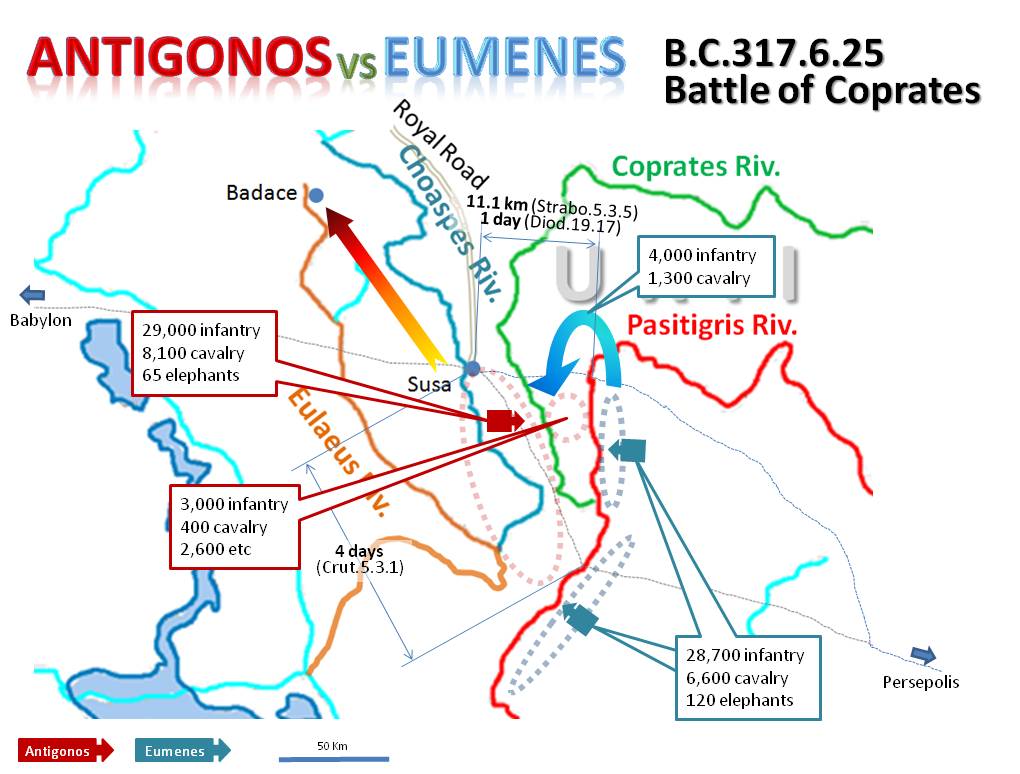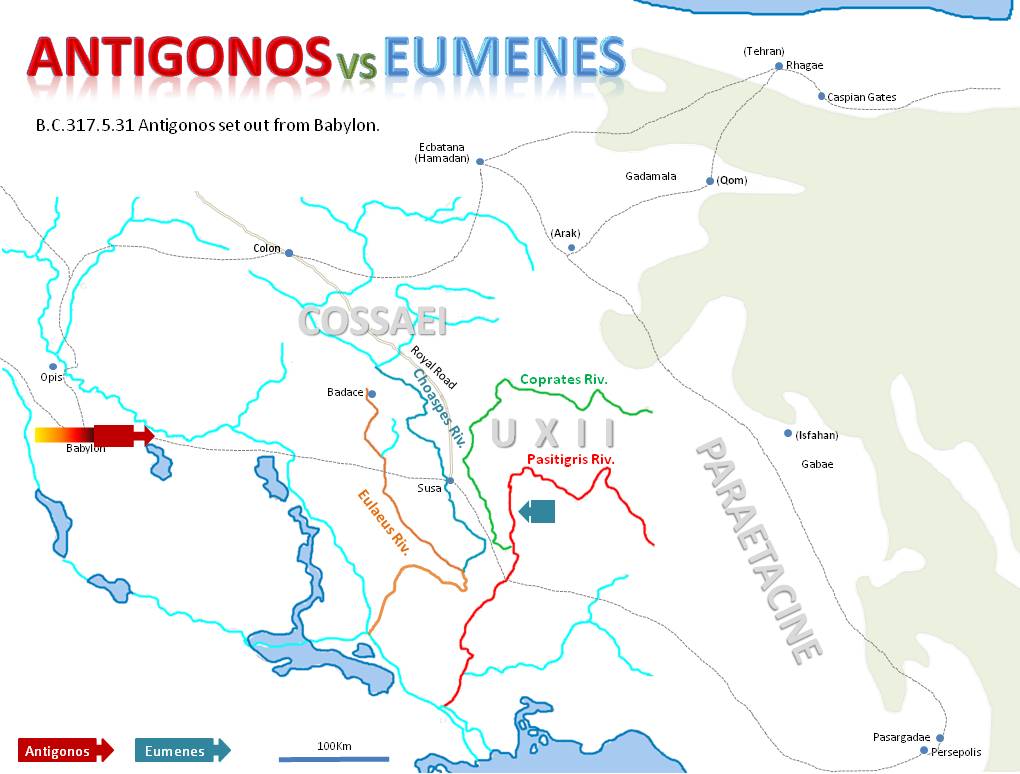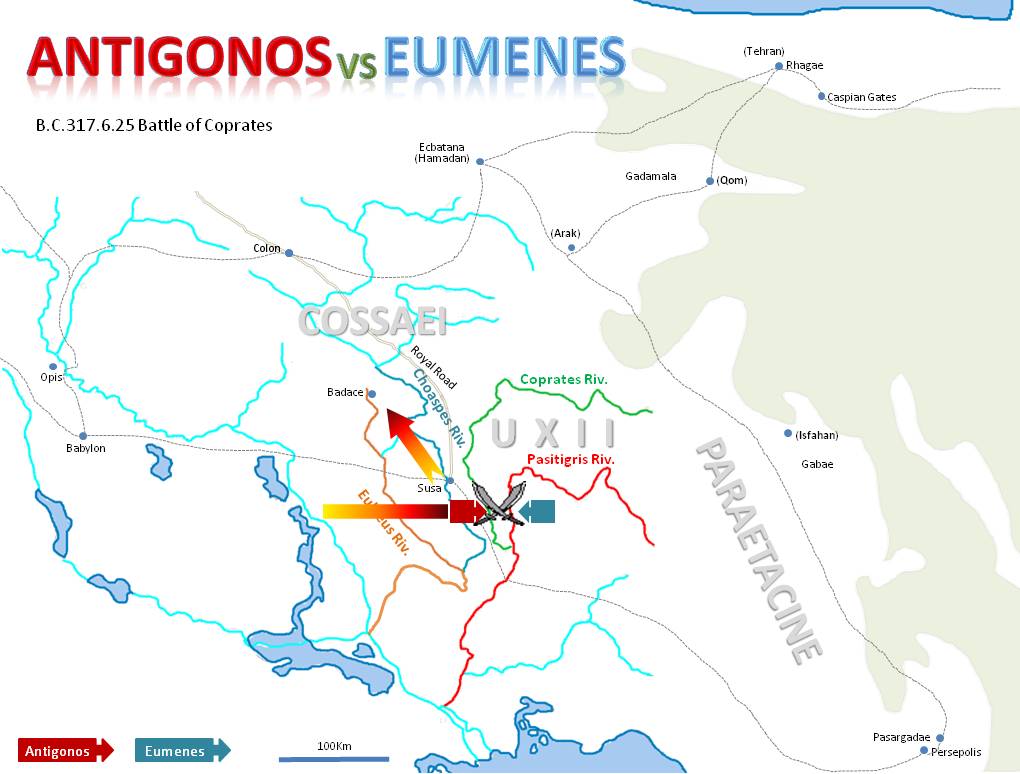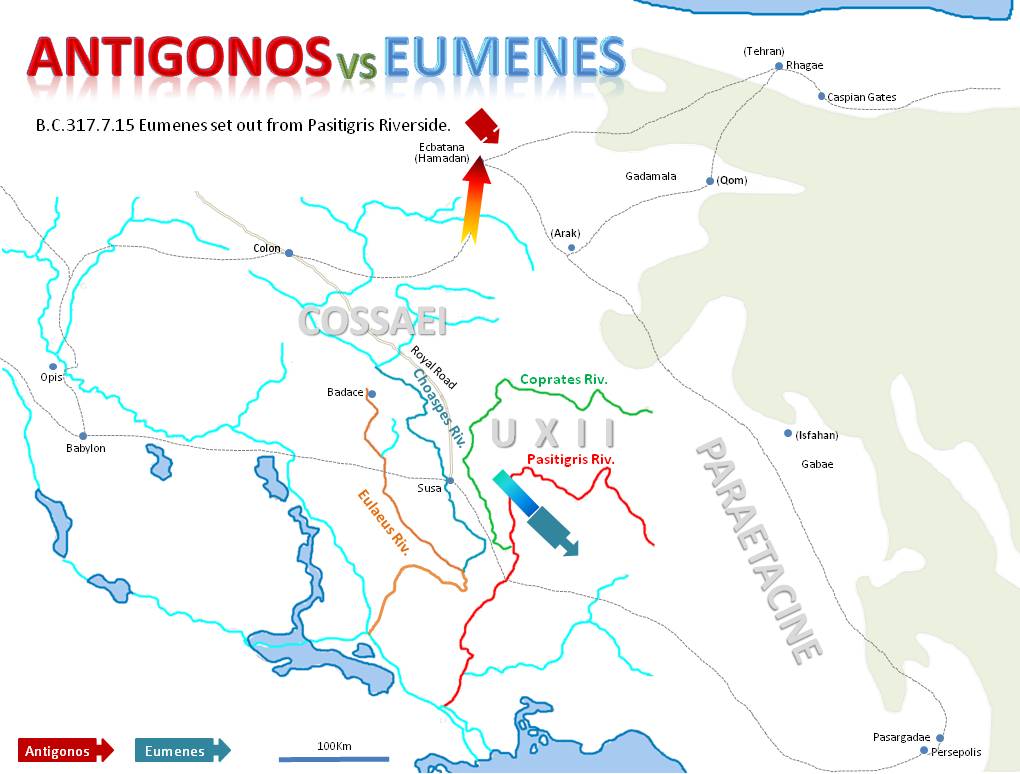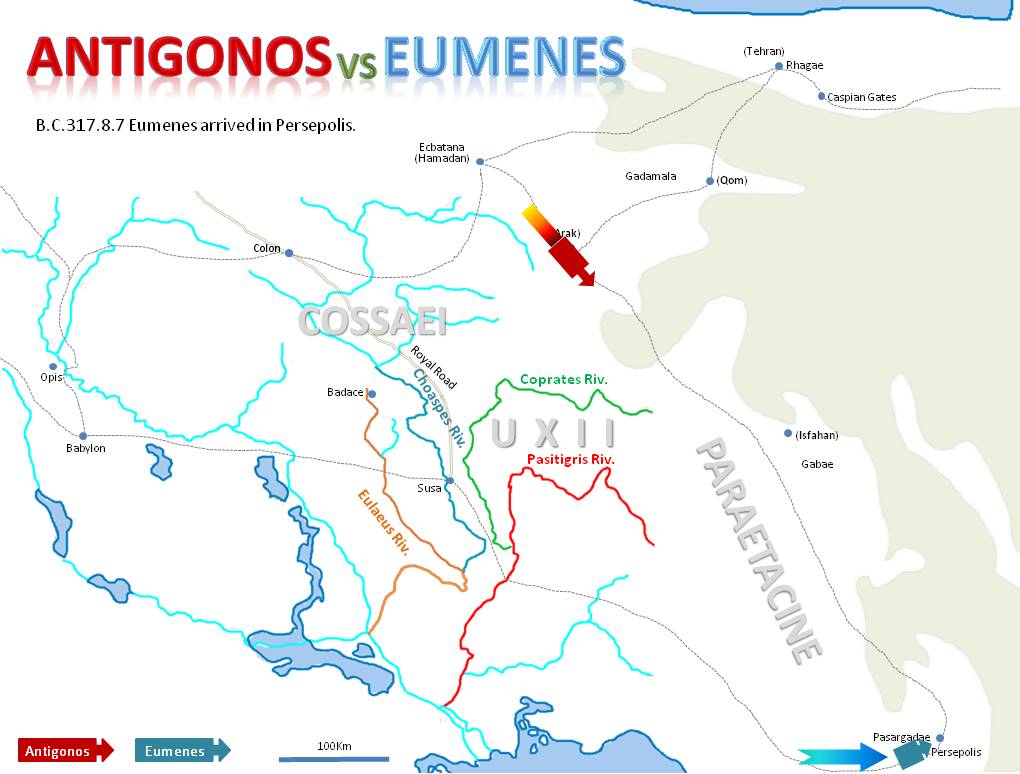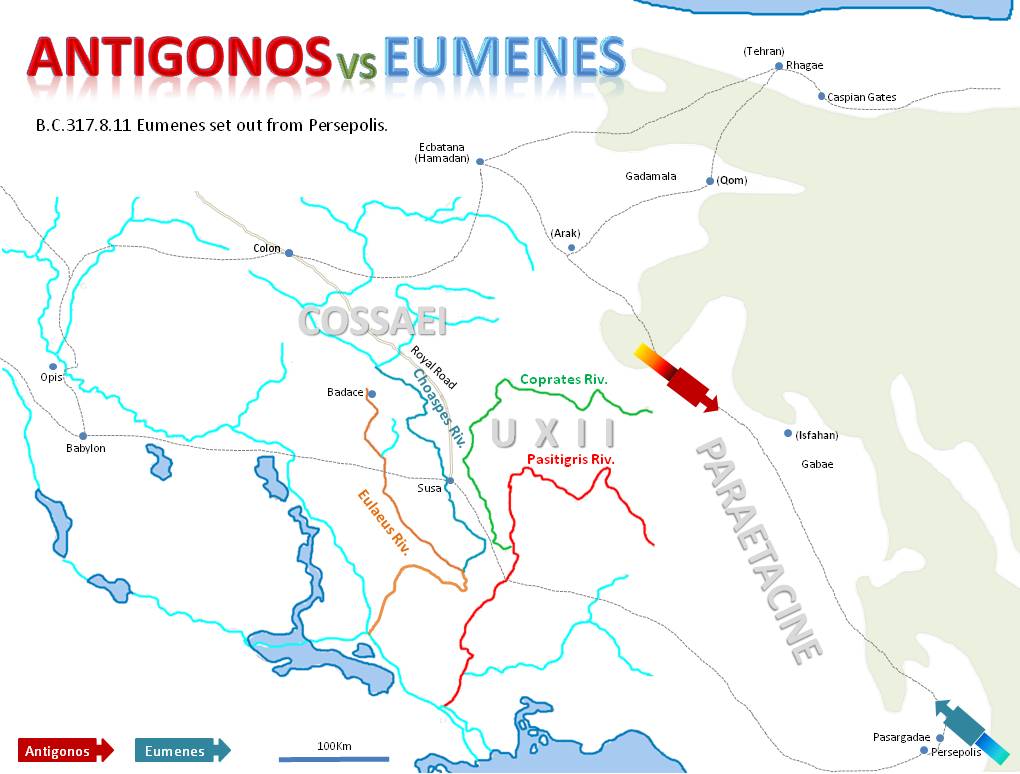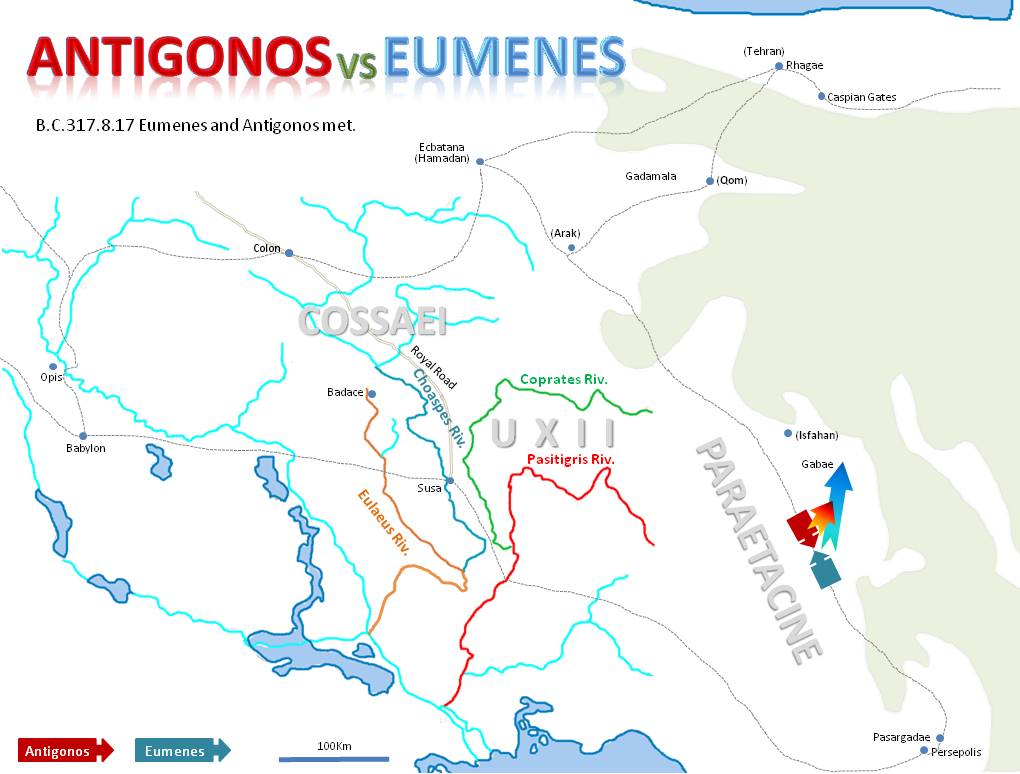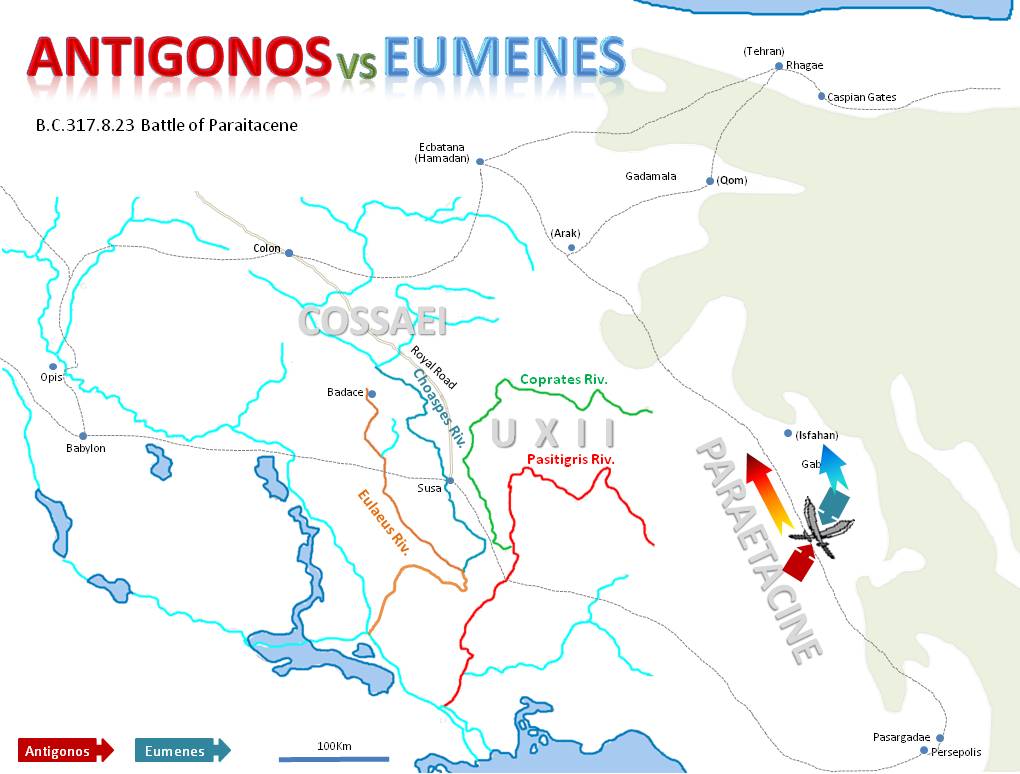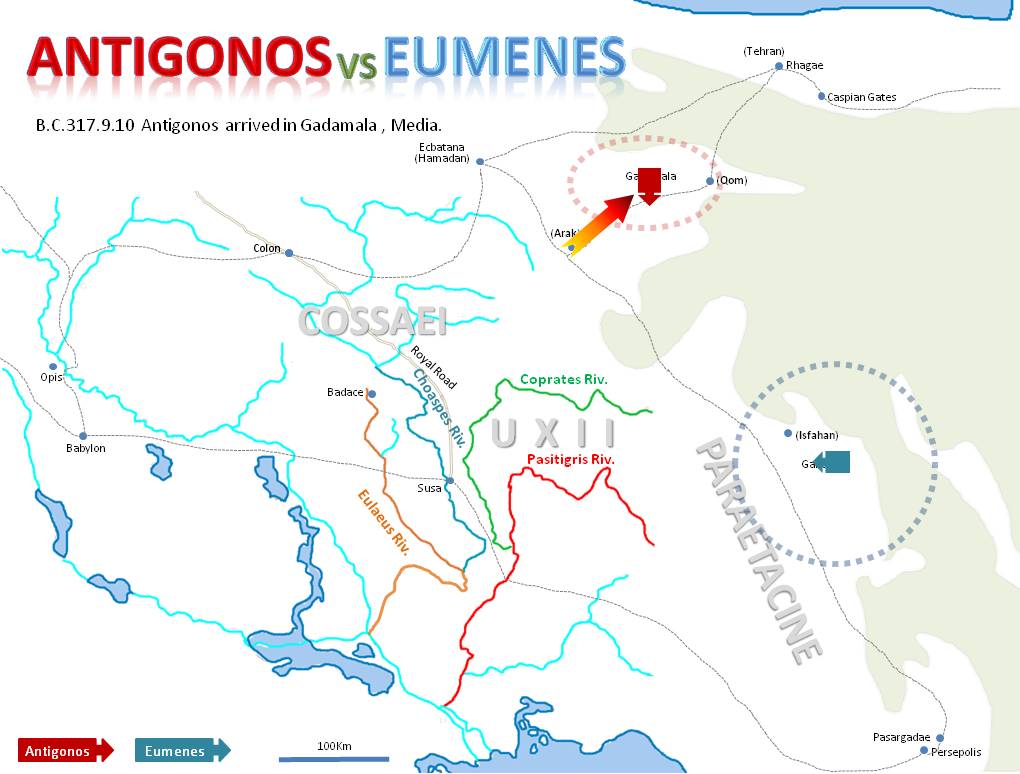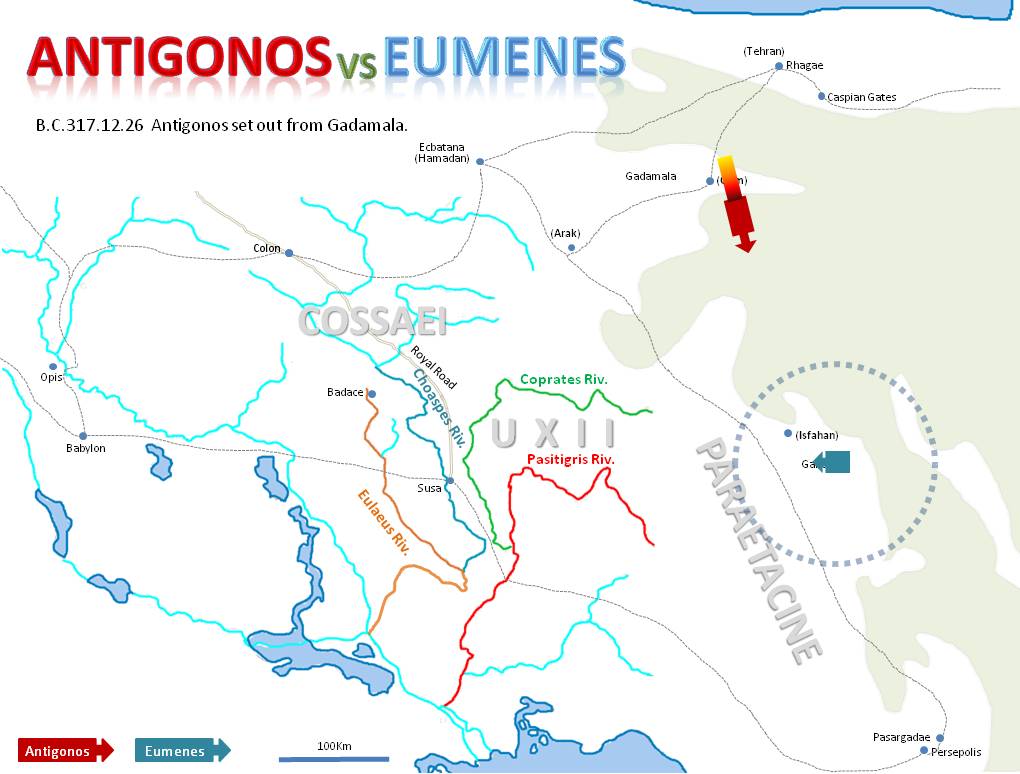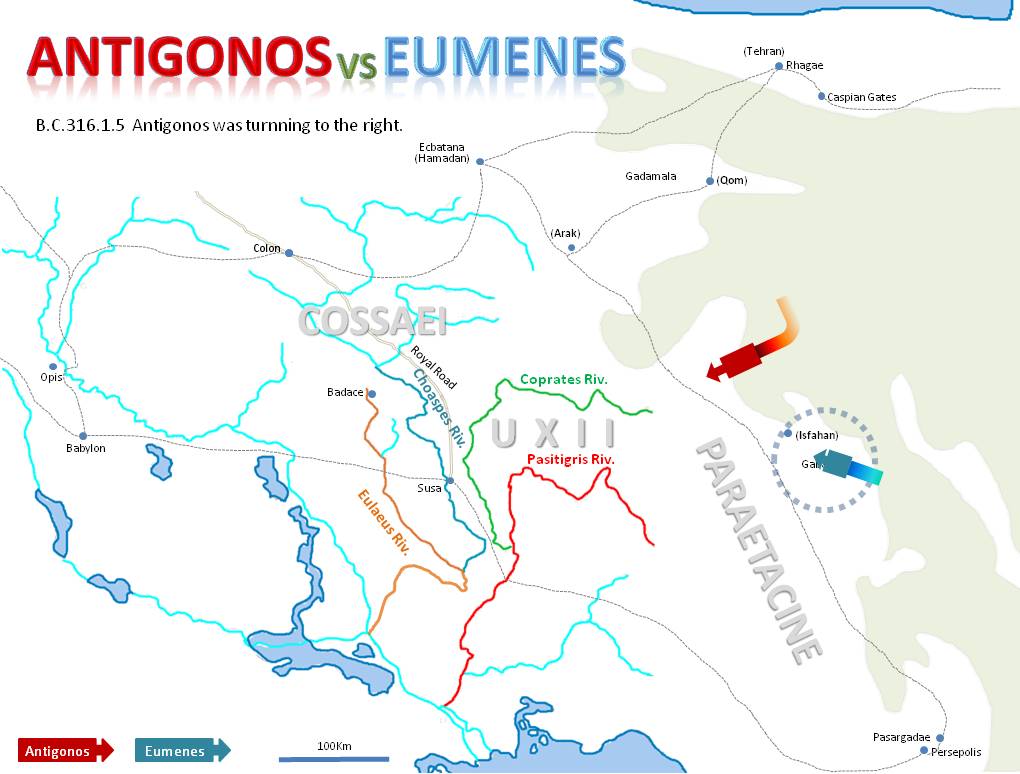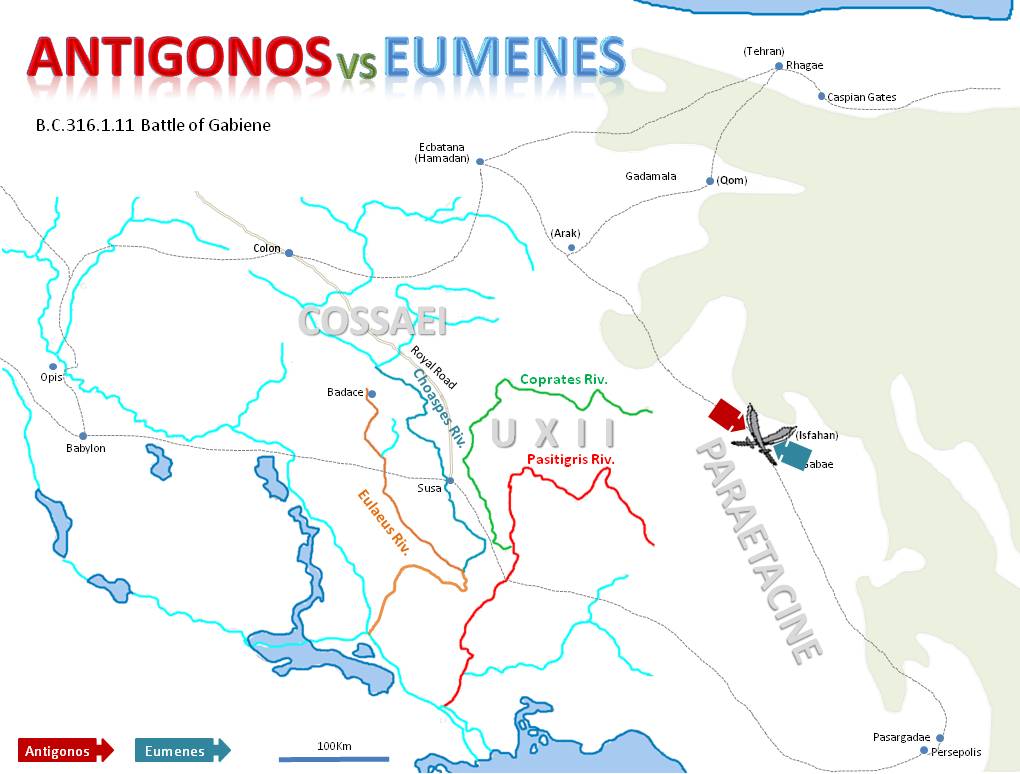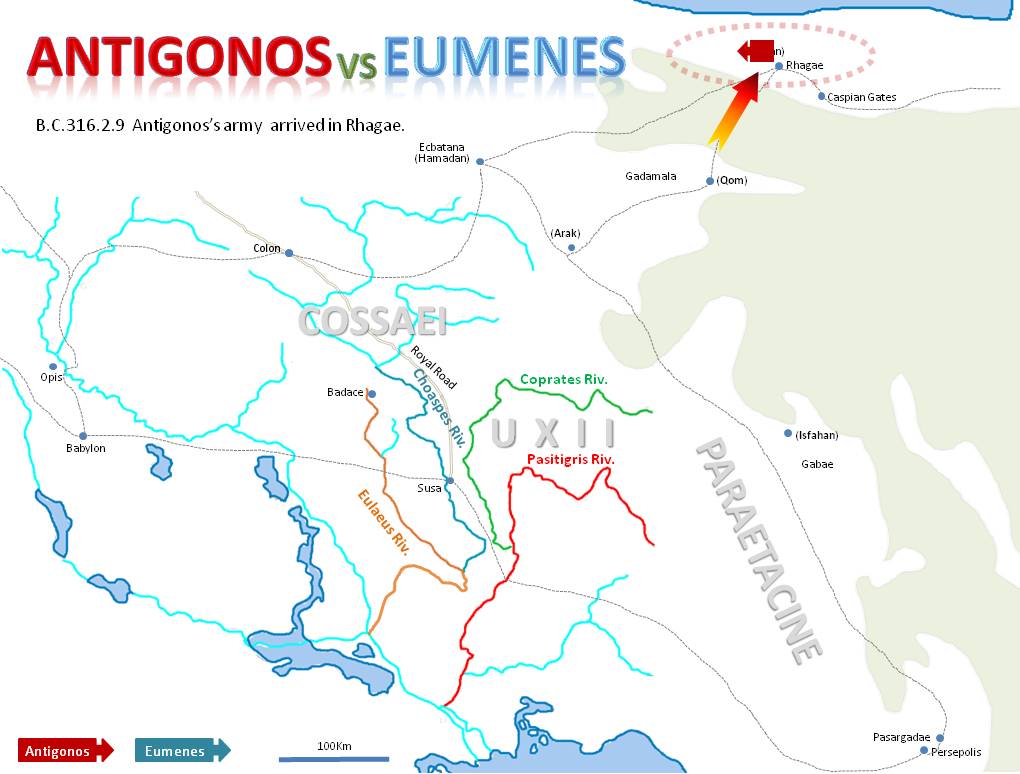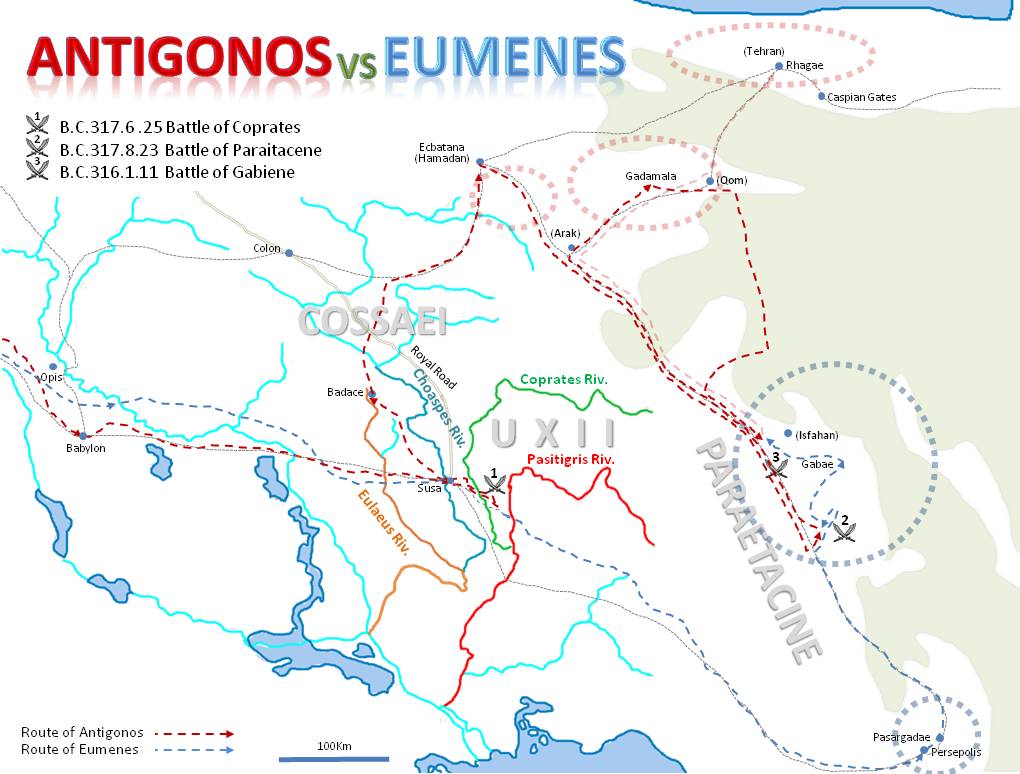B.C.317
04.10 Eumenes set out from the villages of the Carians, Babylonia.
04.10 Pithon arrived in Babylonia.
04.15 Eumenes was attacked Pithon and Seleucus at the Tigris River.
04.20 Seleucus was asking Antigonos to come as soon as possible before the satraps joined Eumenes.
04.26 Antigonos set out from Mesopotamia toward Eumenes.
05.01 Eumenes arrived in Susa.
05.01 Eumenes joined the upper satraps and their armies.
05.05 Antigonos heard that Eumenes joined the upper satraps and their armies.
05.20 Antigonos arrived in Babylon.
05.22 Antigonos made an agreement for common action with Seleucus and Pithon in Babylon.
---> Antigonos received soldiers and 35 elephants from Seleucus.
05.24 Eumenes ordered Xenophilus, who was guarding Susa, not to give any of the money to Antigonos.
05.24 Eumenes set out from Susa.
05.25 Eumenes awaited Antigonos at the other side of the Pasitigris River.
05.26 Eumenes requested Peucestes to summon ten thousand bowmen from Persia.
05.31 Antigonos set out from Babylon. [Diod.19.17]
06.15 Antigonos lost many soldiers because of the heat between Babylon and Susa.
06.20 Antigonos arrived in Susa.
06.20 Antigonos appointed Seleucus satrap of Susiane.
06.20 Antigonos ordered Seleucus to lay siege to Xenophilus, refused to accept his orders.
06.24 Antigonos set out from Susa.
06.25 Battle of Coprates [Diod.19.18, Plut.Eume.14] Strength and Casualties
06.25 Antigonos failed to cross the Coprates River by Eumenes's attack.
07.01 Antigonos arrived in Badace which is situated on the bank of the Eulaeus River.
07.02 Antigonos set out toward Ecbatana from Badace .
07.08 Antigonos lost many soldiers in the Cossaean tribes.
07.11 Antigonos arrived in Ecbatana.
---> Antigonos had met with three great disasters in forty days. (from Babylon 5.31) [Diod.19.20]
07.13 Eumenes heard that Antigonos arrived in Media.
07.15 Eumenes set out from Pasitigris Riverside. [Diod.19.21]
08.04 Antigonos heard that Eumenes set out toward Persepolis.
08.05 Antigonos set out from Media.
08.07 Eumenes arrived in Persepolis. [Diod.19.21]
08.08 Peucestes gave a feast to the army in Persepolis.
08.09 Eumenes had fabricated a false letter that was sent from Orontes, satrap of Armenia.
08.10 Eumenes brought to trial Sibyrtius, who was a friend of Peucestes.
08.10 Sibyrtius fled to Arachosia by perceive the danger.
08.10 Eumenes heard that Antigonos set out from Media.
08.11 Eumenes set out from Persepolis. [Diod.19.24, Plut.Eume.14]
08.13 Eumenes gave a feast to the army, and after he was eagerly engaged in drinking, he became ill.
08.14 Eumenes delayed the march for some days.
08.16 Eumenes had recovered a little and carried in a litter, followed the rearguard.
08.17 Antigonos heard that Eumenes was sick and carried in a litter, and accelerated the march speed.
08.17 Eumenes and Antigonos met. [Diod.19.25, Plut.Eume.14] -> Encounter location
08.17 Antigonos retired with his forces and pitched his camp.
08.17 Both armies encamped at a distance of three stades(about 555m).
08.22 Eumenes anticipated that Antigonos intended to withdraw into Gabene.
08.22 Eumenes departed in advance while Antigonos kept guard on the night attack.
08.23 Antigonos caught up with Eumenes. -> Location
08.23 Battle of Paraitacene [Diod.19.30, Plut.Eume.14] Strength and Casualties
08.23 Demetrius commanded the horsemen on the right wing for the first time.(20 years old)
08.23 Antigonos forced his army to make camp by the bodies, and claimed the victory.
08.23 Eumenes made camp near baggage train, which was some distance away.
08.24 Antigonos set out toward Gadamala, Media.
08.25 Eumenes set out toward Gabene, after the burial of the dead.
08.28 Eumenes was wintering in Gabene.
09.10 Antigonos arrived in Gadamala, Media. [Diod.19.34、Diod.19.37]
---> Gabene is a twenty-five days' march from Gadamala, through desert, a march of nine days.
12.26 Antigonos set out from Gadamala. [Diod.19.37]
---> Eumenes's winter-quarters had spread in the range of about a thousand kilometer. [Diod.19.37, Plut.Eume.15, Poly.4.6.11]
---> Ten days' march through desert tracts, twice the length through everybody travelled route. [Diod.19.37, Nepos.18.8]
12.30 After Antigonos's army had been marching five days, they burned fires in the camps. |
|
The villages of the Carians, Babylonia.
[Eumenes's winter-quarters before Battle of Coprates River.]
The Carians are described as follows in historical records.
1. The Carians who had been forcibly removed to Central Asia, had been posted in the centre at the Battle of Gaugamela. (Arr.3.11.5)
That village, it seems to be would have a major villages with substantial population that the Carians constituted the troops at the same level as the ethnic name at the Battle of Gaugamela.
The Carians are seen as stonemason in Persepolis Treasury Tablets, and I think that they are the descendants of people who were forced to emigrate as a craftsman in the period of such as Xerxes.
35 elephants
The elephants were described as follows in historical records.
1. Hephaestion took with him two hundred elephants along the one side of the Hydaspes River.(Arr. Ind. 19)
2. Krateros marched with him the old soldiers and the elephants from India to Carmania. (Arr.6.17.3, Arr.6.27.3)
3. Hephaestion marched from Carmania to Persis with the larger division of the army and the elephants.(Arr.6.28.7)
4. When the infantry and cavalry were conflict in Babylon, Perdikkas ordered to trample the rebellious soldiers by the feet of the elephants.(Curt.10.9.18)
5. When Perdikkas He invaded to Egypt, he placed the elephants, in order to mitigating the strength of the current of the Nile.(Diod.18.35)
6. When Antipatros left Asia, he gave to Antigonos half the elephants.(Arr.Succ.1.43)
7. In the battle against Eumenes in Kappadokia, Antigonos had 30 elephants.(Diod.18.40)
8. When Antipatros died, Antigonos had 30 elephants.(Diod.18.50)
9. When Polyperchon marched to Attica, he had brought 65 elephants.(Diod.18.68)
From the above, the elephants that brought to Babylon from India by Krateros and Hephaestion will be 130.
Also, either when Perdikkas set out from Babylon, he left a part of the elephants, or after the settlement at Toriparadeisos, Seleucus who became the Satrap of Babylon took a part of the elephants to Babylon, and it seems that there were 35 elephants in Babylon.
The Eulaeus River.
Susa near rivers are described as follows in historical records.
1. Alexander sailed down the Eulaeus River from Susa to the Persian Gulf. (Arr.7.7.1)
2. The Choaspes River and the Eulaeus River meet in a lake. (Strabo.15.3.4)
3. The Euraiosu River poured into the Persian Gulf through the east and west of Susa. (Ptolem.6.3.2)
4. Susa is situated in the interior on the Choaspes River. (Strabo.15.3.4, Paus.10.31.7)
5. Alexander who went to Susa from Babylon was greeted with The Choaspes River. (Curt.5.2.9)
6. For after the Choaspes River, one comes to the Coprates River and the Pasitigris River. (Strabo.15.3.6)
7. This Coprates River enters the Pasitigris River. (Diod.19.18)
8. Believing that the crossing of the Coprates River was impossible, Antigonos set out toward the city of Badace, which is situated on the bank of the Eulaeus River. (Diod.19.19)
From the above, the positional relationship between the Susa and river seems from the west in the order the Eulaeus River, the Choaspes River, the Coprates River, and the Pasitigris River.
Badace
[Antigonos’ camp after Battle of Coprates River.]
There were two roads leading into Media from Badace, the road leading to Colon was a good royal highway, extending for almost forty days' march; while the other, which passed through the Cossaean tribes was the nine day’ march. (Diod.19.19)
From the above, the position of Badace seems upstream of the Eulaeus River, and near the Cossaean tribes.
Gabene
[Eumenes's winter-quarters before Battle of Gabiene.]
Gabene is described as follows in historical records.
1. Eumenes concluded that Antigonos intended to withdraw into Gabene from where both met.(Diod.19.26)
2. Eumenes moved the army into Gabene after Battle of Paraitacene. (Diod.19.34)
3. Eumenes’s armies distributed themselves in winter quarters over almost the whole of Gabene. (Plut.Eume.15)
4. The distance from the place where Antigonos and Eumenes met, to Gabene was about three days' march. (Diod.19.26)
5. There was a palace in Gabae, in the upper parts of Persis. (Strabo.15.3.3)
Battle of Paraitacene
[Strength]
Antigonos : 28,000 infantry, 8,500 cavalry, 65 elephants
Eumenes : 35,000 infantry, 6,100 cavalry, 114 elephants
[Casualties]
Antigonos : 3,700 infantry and 54 cavalry killed; more 4,000 wounded
Eumenes : 540 infantry and few cavalry killed; more 900 wounded
Battle of Gabiene
[Strength]
Antigonos : 22,000 infantry, 9,000 cavalry, 65 elephants
Eumenes : 36,700 infantry, 6,000 cavalry, 114 elephants
[Casualties]
Antigonos : more 5,000 killed
Eumenes : 300 killed
Gadamala (Gamarga, Gadamarta)
[Antigonos ‘s winter-quarters before Battle of Gabiene.]
Gadamala is described as follows in historical records.
1. Antigonos went as far as Gamarga in Media, a land that was subject to Pithon. (Diod.19.32)
2. Antigonos was wintering in Gadamala in Media. (Diod.19.37)
3. While Antigonos lay in winter-quarters at Gadamarta, a city of Media, Eumenes blocked him up there, with a cordon of troops spread over a distance of a thousand stades. (Poly.4.6.11)
Rhagae (Rhaga)
[Antigonos ‘s winter-quarters after Battle of Gabiene.]
Rhagae is described as follows in historical records.
1. Antigonos distributed the soldiers in the eparchy called Rhagae, which had received this name from a catastrophe that had occurred there in former times. (Diod.19.44)
2. Rhagae in Media has received its name because the earth about the Caspian Gates had been "rent" by earthquakes. (Strabo.1.3.19)
3. The distance from the Caspian Gates to Rhagae is five hundred stadia. Rhagae is said to have got its name from the earthquakes that took place in that country, by which numerous cities and two thousand villages. (Strabo.11.9.1)
4. Rhaga was founded and named Europus by Nicator, but by the Parthians Arsacia.
Rhaga lies about five hundred stadia to the south of the Caspian Gates. (Strabo.11.13.6)
5. Parthians king spent the winter in Babylon, spent the spring in Rhagae. (Athen.12.513F)
6. Rhagae is distant from the Caspian Gates one day's journey to one marching. (Arr. 3.20.2)
7. The other towns of Media were Phisganzaga and Apameia called Rhagiane.(Pliny.6.43) |
Antigonos and Eumenes's Encounter location.(M)
1. Number of days that Antigonos took from Ecbatana to Persepolis about 20 days(Diod.19.46)
Distance from Ecbatana between Persepolis about 775km
Marching distance of the day about 38km
2. On the second day of the journey from Persepolis, Eumenes entertained the army, and he was eagerly engaged in drinking, and he became ill. (Diod.19.24)
3. Eumenes had recovered a little and carried in a litter, followed the rearguard. (Diod.19.24)
4. Antigonos heard from his prisoners that Eumenes was sick and carried in a litter, and accelerated the march speed. (Plut.Eume.15)
5. When Eumenes encountered Antigonos, he carried in a litter. (Plut.Eume.14)
From the above, Number of days after Eumenes has resumed the march, seems at least 2 days, and at the longest 4 days.
Therefore, (M) is 152km(4 days) – 228km(6 days) from Persepolis.
The location that Antigonos caught up with Eumenes (N)
[The location of Battle of Paraitacene]
Eumenes had a start of two watches. 6 hours
Antigonos himself with the cavalry 17.6km/h
See The Man versus Horse Marathon
https://en.wikipedia.org/wiki/Man_versus_Horse_Marathon
22mile = 35.2km The fastest horse is 2 hours. 17.6km/h
Eumenes’s army 5 km/h (Eumenes sent the baggage on ahead.)
Time required for the Antigonos catches up with Eumenes (H)
17.6 × H = 5 × H + 5 × 6
H = 30 ÷ (17.6 – 5) ≒ 2.38h = 2h23m
17.6 × 2.38 = 41.9km
Distance from (M) between (N) about 41.9km
From Eumenes’s start from (M) 8 hours 23 minutes after
Antigonos overtook the rearguard of the enemy at daybreak. (Diod.19.26)
(N)’s dawn time of August 23 4:28 a.m.
http://www.hoshi-lab.info/env/solar.html
Eumenes’s start time from (M) B.C.317.8.22 20:05 p.m.
Antigonos’s start time from (M) B.C.317.8.23 2:05 a.m. |
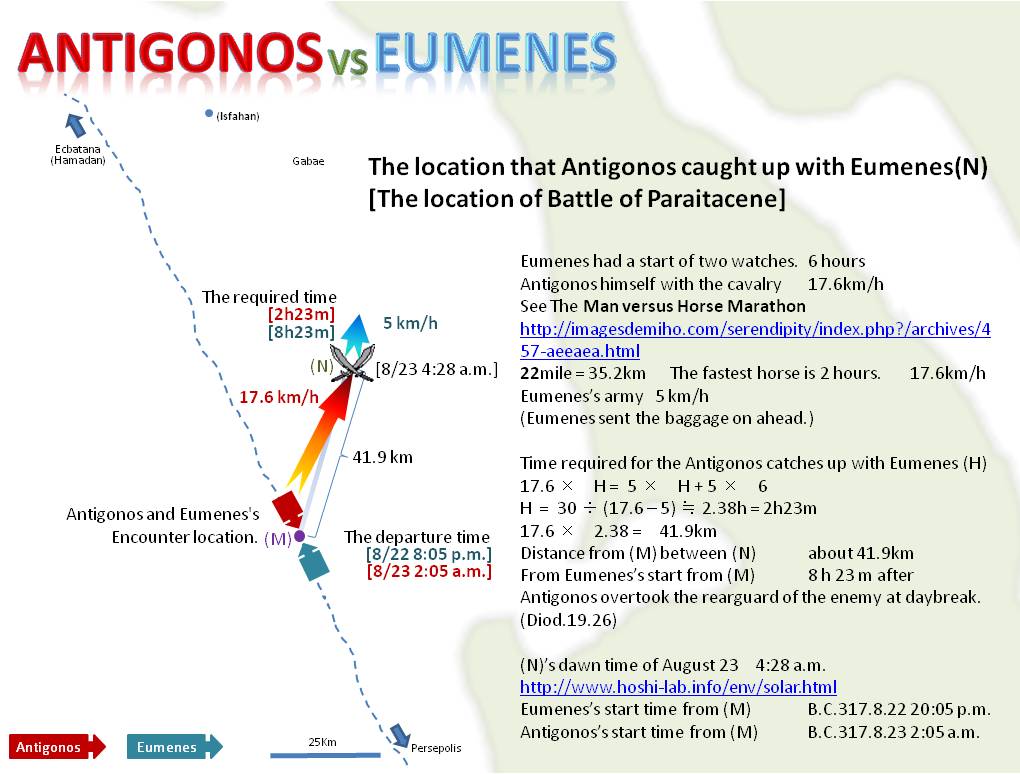 |
